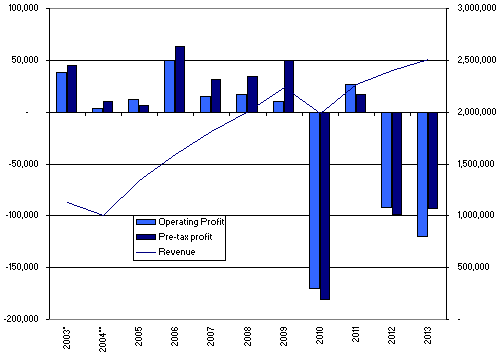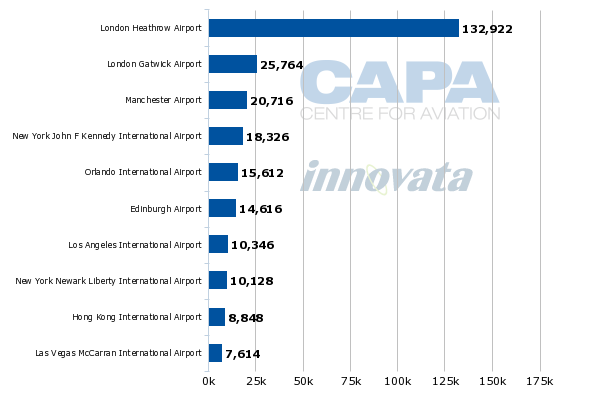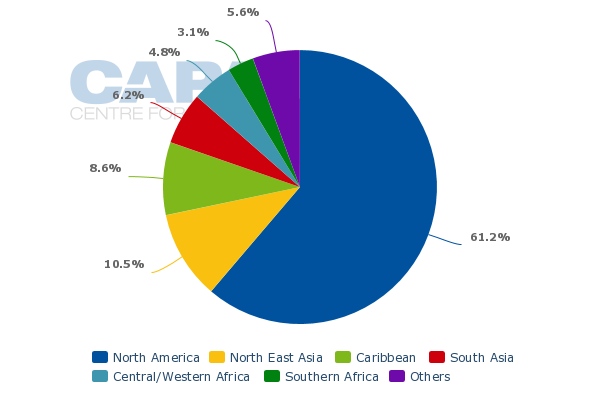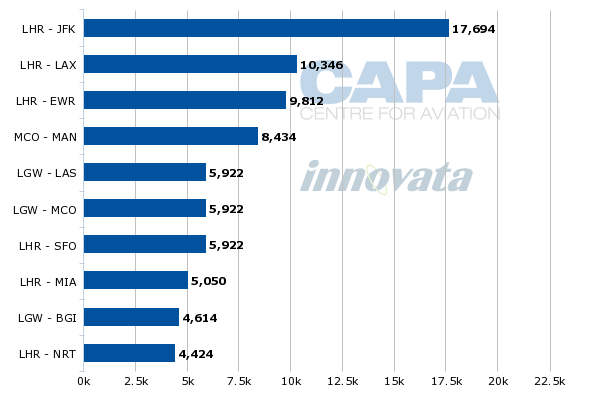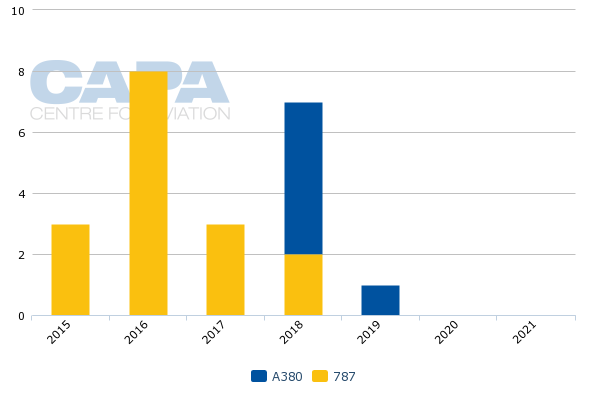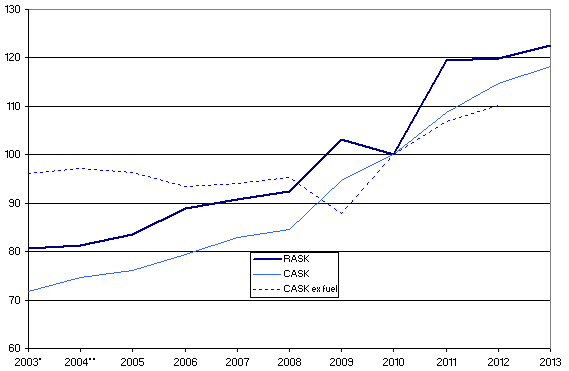Virgin Atlantic Airways' track record of losses: partnerships should help. Cost cutting would
In part one of our report on Virgin Atlantic, we considered the factors that might influence its decision on whether or not to join the SkyTeam alliance, concluding that remaining outside the alliance may be sensible, at least for now. In this second of two parts, we provide some context for VA's strategic developments through an analysis of its network and the accounts that it files with Companies House.
Its point-to-point focused network is still weighted towards the North Atlantic, but it has also seen growth in Asia and added domestic routes in 2013. It does not have a hub that it dominates and is the leading airline on only a small number of (mainly leisure-focused) routes.
Virgin Atlantic has made an annual profit only once in the past four years and saw a widening of underlying losses in its most recent annual accounts. The number one priority should be to take action to reduce these losses.
See related report: Virgin Atlantic's track record of losses: Delta should help but what about SkyTeam?
Another year of losses in the year to Feb-2013
To set Virgin Atlantic's decision on an alliance into a financial context, we present some analysis of its most recent annual results. The airline has not reported any of the details in press releases, but CAPA has analysed the accounts filed by Virgin Atlantic Airways Limited with the UK's Companies House for the year ended 28-Feb-2013 (FY2013) and traffic data reported to the Civil Aviation Authority. The period in question mainly pre-dates the arrival of CEO Craig Kreeger, who joined on 1-Feb-2013.
Virgin Atlantic Airways Ltd reported a pre-tax loss of GBP93 million for FY2013, compared with a GBP99 million loss in the previous year. However, the FY2013 result included a positive one-off figure of GBP35 million related to the reversal of a provision taken in FY2010 in connection with investigations in price-fixing by the competition authorities. The FY2013 operating result excluding this exceptional item was a loss of GBP120 million, representing a widening by 31% of the FY2012 operating loss.
Virgin Atlantic Airways Ltd revenue, operating profit and pre-tax profit (GBP000): 2012 and 2013 (financial year to end Feb)
| GBP million | FY2012 | FY2013 | change |
|---|---|---|---|
| Revenue | 2,402.1 | 2,505.2 | 4.3% |
| Operating costs | 2,494.2 | 2,625.5 | 5.3% |
| Operating profit* | -92.1 | -120.3 | 30.6% |
| Pre-tax profit | -98.6 | -93 | -5.7% |
| Pax million | 5.3 | 5.5 | 3.5% |
| ASK million | 49.2 | 50.2 | 2.1% |
| Passenger load factor % | 77.5 | 78.7 | +1.2 ppts |
| RASK GBP pence | 4.88 | 4.99 | 2.1% |
| CASK GBP pence | 5.07 | 5.23 | 3.0% |
Revenues grew by 4.3%, but operating costs grew by 5.3%. Virgin Atlantic's annual report does not separate fuel costs, but higher fuel prices net of hedging contributed to the growth in costs. Employee costs grew by 6.1%, faster than the total, due to a 4% increase in average headcount and a 2% increase in average staff cost per employee. Operating costs per ASK (CASK) grew by 3.0%, more rapidly than the 2.1% increase in revenues per ASK (RASK).
The FY2013 losses were Virgin Atlantic's fourth year of red ink in the past five and the widening of the underlying operating loss was the second successive year of deteriorating profitability, in spite of revenue growth. This suggests a need to re-double cost cutting efforts.
Virgin Atlantic Airways Ltd revenue, operating profit and pre-tax profit (GBP000): 2003* to 2013 (financial year to end Feb)
North America drives revenue growth
In terms of area of destination, Virgin Atlantic's revenue growth in FY2013 was driven by North America, which accounted for more than half of its revenues (see table below). The Far East, its second biggest revenue region, also enjoyed healthy growth, while revenues to Africa declined. Caribbean revenues were broadly stable.
Virgin Atlantic Airways scheduled revenue by destination: FY2012 and FY2013 (Feb year end)
|
GBP million |
FY2012 |
FY2013 |
Change |
% of 2013 total |
|---|---|---|---|---|
|
N America |
1,278 |
1,334 |
4.4% |
54% |
|
230 |
231 |
0.4% |
9% |
|
|
Far East |
319 |
333 |
4.4% |
13% |
|
304 |
289 |
-4.9% |
12% |
|
|
Other |
254 |
302 |
18.9% |
12% |
|
Total |
2,385 |
2,489 |
4.4% |
100% |
Load factor gains in FY2013, but not in 1QFY2014
In FY2013, ASKs were up 2.1%, passenger numbers up 3.5% and load factor gained 1.2 ppts to 78.7%. This was the second successive year of ASK growth after three previous annual cuts in capacity and marked a welcome return to a rising load factor trend after some years of volatility. Load factor is again approaching the AEA overall average level of 79.2%, but it remains well short of the AEA long-haul average of 82.9% (both figures are for calendar 2012). Higher load factors must be a priority, although the new domestic routes may have a dilutive impact (AEA average domestic load factor is 69.5%).
In the first three months of FY2014 (Mar-2013 to May-2013), ASKs grew by 1.8% and load factor fell by 0.4 ppts to 76.2%, according to data from the CAA.
Virgin Atlantic Airways development of passenger capacity (ASKs), traffic (RPKs) and load factor (%): 2003* to 2013 (financial year to end Feb)
Four strategic areas of focus
New CEO Craig Kreeger has outlined a strategy to improve Virgin Atlantic's financial performance. This consists of four areas:
1) the launch of Virgin Atlantic Little Red to operate UK domestic routes and improve feed into the long-haul network;
2) the Delta joint venture offering more North American connections and widening the sales base;
3) ongoing fleet improvements, and
4) cost savings, with a target of GBP45 million in the current financial year.
Virgin Atlantic is Heathrow's number two airline
Virgin Atlantic's main base is London Heathrow, but it also has a fairly significant presence at London Gatwick, Manchester and Edinburgh.
It is the second biggest airline by seats at Heathrow, number six at Gatwick, number six at Manchester and in fifth place at Edinburgh. It is also number five at its other UK airport, Aberdeen. While its long-haul focus reduces the significance of these rankings, as many of the higher-placed carriers are short-haul only, its lack of a base that it can dominate is a handicap.
Virgin Atlantic Airways top 10 hubs/bases/stations by seats: 16-Sep-2013 to 23-Sep-2013
Domestic routes have been added but long-haul dominates
Since our May-2013 analysis report on Virgin Atlantic it has added domestic routes under the 'Little Red' brand and operated by Aer Lingus under wet lease arrangements. The Virgin Atlantic network is still dominated by its international routes, but 18% of its seat capacity is now domestic (less than 2% of ASKs) (week of 16-Sep-2013, source: Innovata).
See related report: Virgin Atlantic, the flying enigma - a great brand in need of greater financial discipline
Virgin Atlantic Airways Network Summary: at 22-Sep-2013
|
Region |
Number of airports
|
|---|---|
|
Domestic |
6 |
|
3 |
|
|
6 |
|
|
0 |
|
|
7 |
|
|
1 |
|
|
11 |
|
|
Total non-stop passenger destinations |
34 |
Excluding the new domestic services, 61% of Virgin Atlantic's international seat capacity is to North America, 11% to Northeast Asia and 9% to the Caribbean.
The regional split of its international seat capacity is broadly similar in Sep-2013 to how it was in May-2013, with the exception that there has been a swing of roughly 3 ppts from the Caribbean to North America. The United States is by some distance Virgin Atlantic's most important destination country.
Virgin Atlantic Airways international capacity by region (% of seats): 16-Sep-2013 to 23-Sep-2013
Virgin Atlantic Airways international seat capacity by country 16-Sep-2013 to 23-Sep-2013
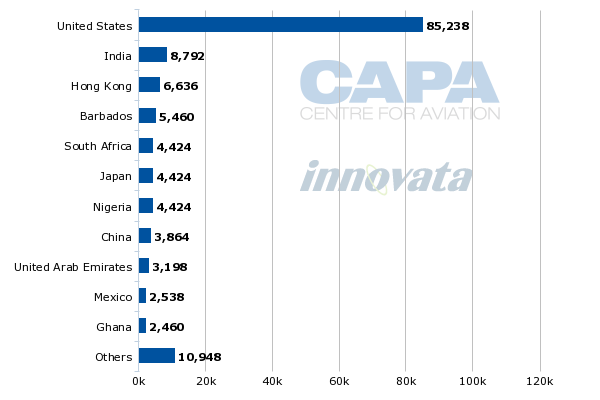
Only one of its top ten international routes (London Heathrow to Tokyo Narita) does not involve the Atlantic Ocean: eight are UK-US and one is UK-Caribbean (Gatwick-Bridgetown). Out of its top ten bases, only Hong Kong is not in the UK, US or Caribbean. The Atlantic continues to be key to the airline, as suggested by its name.
Virgin Atlantic Airways top 10 international routes by seats: 16-Sep-2013 to 23-Sep-2013
The competitive position is mixed
Virgin Atlantic's competitive position on its top 10 international routes by seats is mixed. It is number one on only four of the city pairs, each to a primarily leisure destination (Orlando, Las Vegas and Bridgetown). Moreover, on London to Las Vegas, British Airways has almost identical weekly seat capacity to Virgin Atlantic and, in the winter schedule, it will have more and push Virgin Atlantic into the number two position.
Where it is number two, on London to New York and Los Angeles, it faces competition from three or four other competitors in addition to leader British Airways. Its new alliance with Delta will only have an impact on London to New York, since Delta does not fly to the UK from any other Virgin destination in the list. However, the pair do both fly on Heathrow to Boston, although this is not in Virgin Atlantic's top 10.
Virgin Atlantic Airways market position on its top 10 international routes by seats: 16-Sep-2013 to 22-Sep-2013
|
Route |
Virgin Atlantic Airways
|
Competitors on city pair |
|---|---|---|
|
London Heathrow-New York JFK |
2 |
1 British Airways, 2 Virgin Atlantic, 3 American, 4 United,
|
|
London Heathrow-Los Angeles |
2 |
1 British Airways, 2 Virgin Atlantic, 3 Air New Zealand,
|
|
2 |
1 British Airways, 2 Virgin Atlantic, 3 American, 4 United,
|
|
|
Manchester-Orlando |
1 |
|
|
1 |
||
|
London Gatwick-Orlando |
1 |
|
|
3 |
1 United, 2 British Airways, 3 Virgin Atlantic |
|
|
3 |
1 British Airways, 2 American, 3 Virgin Atlantic |
|
|
1 |
||
|
3 |
1 JAL, 2 British Airways, 3 Virgin Atlantic, 4 ANA |
Virgin Atlantic's new UK domestic routes from London Heathrow, which it entered when BA was forced to concede remedy slots after buying bmi, are a duopoly on an airport to airport basis, with Virgin having roughly half the capacity of BA. On a city pair basis, i.e. including all London airports to the three UK cities, Virgin is pushed into third place by easyJet to Edinburgh, but just edges easyJet into third place to Aberdeen.
As easyJet does not fly from Virgin Atlantic's Heathrow hub, the impact on the latter's feed there is unlikely to be very significant, although Virgin Atlantic's long-haul routes at Gatwick may be a little vulnerable to easyJet's presence on Gatwick to Edinburgh and Aberdeen. easyJet does not operate on London to Manchester.
Virgin Atlantic Airways market position on domestic routes by seats: 16-Sep-2013 to 22-Sep-2013
|
Route |
Virgin Atlantic
|
Competitors on airport pair |
Competitors on city pair |
|---|---|---|---|
|
2 |
1 British Airways, 2 easyJet, 3 Virgin Atlantic |
||
|
2 |
|||
|
2 |
1 British Airways, 2 Virgin Atlantic, 3 easyJet |
A predominantly Airbus fleet, but Dreamliners are coming
Virgin Atlantic's fleet contains 12 Boeing 747-400s, whose average age is almost 14 years and 18 Airbus A340s averaging nearly 10 years. Its 10 A330s are just under two years old, having entered the fleet from early 2011, first to replace ageing A340s and then to provide growth.
Virgin Atlantic points to manufacturer claims that the A330-300s are 15% more fuel efficient than the aircraft they replace. The overall average age of its fleet is just over nine years, a little younger than most major European network carriers and the world average of around 12 years.
The fleet details in the table below include four Airbus A320-200 aircraft wet leased from Aer Lingus for services connecting London Heathrow to Manchester, Edinburgh and Aberdeen under Virgin's "Little Red" brand.
Virgin Atlantic Airways Fleet Summary: as at 18-Sep-2013
|
Aircraft |
In service |
Average age
|
On order |
|---|---|---|---|
|
A320-200 |
4 |
9.2 |
|
|
A330-300E |
10 |
1.9 |
|
|
A340-300 |
1 |
|
|
|
A340-300X |
3 |
|
|
|
A340-600 |
13 |
|
|
|
A340-600 (HGW) |
1 |
(all A340 fleet) 9.9 |
|
|
12 |
14.3 |
|
|
|
Total in service |
44 |
9.2 |
|
|
of which: |
|
|
|
|
Leased |
39 |
|
|
|
Owned |
5 |
|
|
|
On order |
|
|
|
|
A380-800 |
|
|
6 |
|
|
|
16 |
|
|
Total on order |
|
|
22 |
Virgin Atlantic's six Airbus A380s that are on order are expected to be delivered in 2018 and 2019, while delivery of 16 Boeing 787s should start in 2015 and continue to 2018. These aircraft should further improve fuel efficiency.
Virgin Atlantic Airways projected delivery dates: as at 18-Sep-2013
Virgin Atlantic's CASK is in line with European legacy airlines, but rising
The increase in CASK in FY2013 was accompanied by a levelling out of average sector length after a number of years of slightly declining distances. Virgin Atlantic now sits roughly on the trend line for European legacy carriers in a scatter plot of CASK versus average sector length. It has no direct equivalent competitor among European carriers, due to its long-haul focus (the FY2013 results pre-date its recent modest addition of short-haul routes).
However, its unit costs - taking sector length into account - are less efficient than many competitors from other regions on its long-haul routes.
Unit costs (cost per available seat kilometre) and average sector length for selected European legacy and low-cost carriers: 2012*
Virgin Atlantic's focus must be on costs
The chart below updates our analysis of Virgin Atlantic Airways' RASK and CASK trends. Since Virgin Atlantic's last positive operating result in FY2011, its RASK increase has failed to keep pace with CASK growth. Increased fuel prices did not help, but ex fuel CASK has also grown faster than RASK (at least in FY2012; we do not have fuel cost data for FY2013).
Moreover, ex fuel CASK, which was well contained until FY2009, has been on a worryingly upward curve since FY2009. The profit recovery from FY2010 to FY2011 was driven by a sharp rise in RASK, but similar unit revenue improvements have proved elusive since then.
In our last analysis report in May-2013, we noted: "These trends suggest that VA has not had a strong cost control culture and that, in spite of its strong branding, it has been unable to fill its aircraft sufficiently to cover its costs."
See related report: Virgin Atlantic, the flying enigma - a great brand in need of greater financial discipline
Virgin Atlantic's results for FY2013 do nothing to change this analysis. The Delta JV is not yet implemented and will take time to reach cruising speed. Moreover, any decision to join SkyTeam will have a significant lead time.
This puts the current focus firmly on costs and, while the GBP45 million savings target is a start, it may not be enough given the losses in FY2013.
Virgin Atlantic Airways - index of operating cost per ASK and revenues per ASK financial years ended Feb-2003* to 2013 (each indexed to 100 in 2010)
See related reports:
